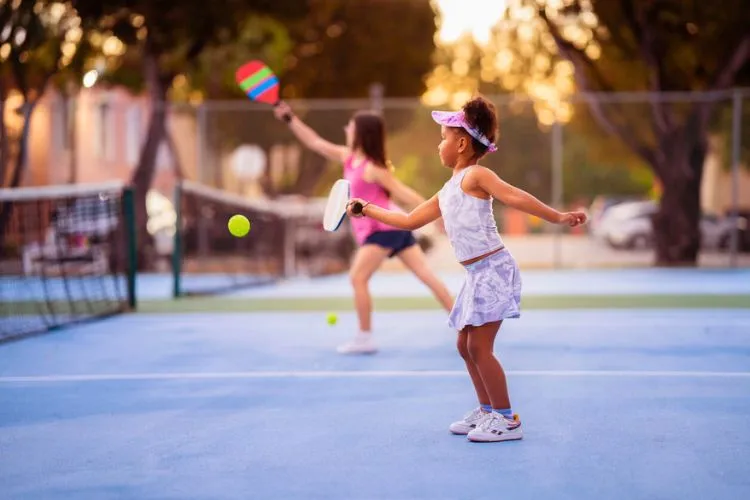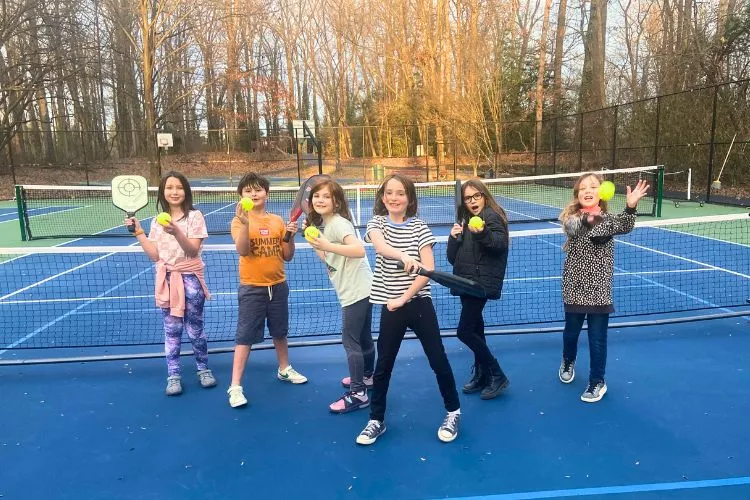Looking for a fun, engaging, and easy-to-learn sport to introduce your child to? Look no further! Pickleball is a smash hit combining elements of tennis, badminton, and ping-pong, making it the perfect child-away sport.
This article will provide valuable insights, tips, and tricks on how do you introduce a child to pickleball and fall in love with the exciting game of pickleball. Join us in discovering this unique sport with families, kids, and communities hooked!

How do you introduce a child to pickleball?
Pickleball is a wonderful, inclusive sport that blends elements from tennis, badminton, and ping-pong. Here’s how you can introduce your child to this vibrant sport:
- Begin with the Basics: Understanding the game can make participation more fun. Start by explaining the basic rules and the objective of the game: to volley the ball back and forth across the net, trying to land the ball within the opposing team’s courts. You can make this a fun process by engaging your child in interactive tutorials or fun visual content.
- Invest in Child-friendly Equipment: Use lightweight paddles and softer balls that are less intimidating and easier for a child to handle. Good equipment can greatly impact the child’s first experience with the sport, so ensure you pick the right paddles and balls suitable for their age and strength.
- Show Them the Game: Your kids should watch a game before they play. Whether it’s an online video or a local match, this will give them an idea of how the game is played and excite them about learning these skills.
- Teach Basic Skills: Start with the simplest skills, like holding the paddle properly and hitting the ball. You can create enjoyable drills to help improve their hand-eye coordination and familiarize them with movement patterns in the game.
- Play a Simple Game: Initially, focus on fun and engagement rather than competition. Encourage them to hit the ball back and forth. This will reinforce their basic skills, increase their confidence and lay the groundwork for more complex gameplay later.
- Encourage Them: Positive reinforcement is the best way to help your child keep their enthusiasm. Celebrate their successes and improvements, even if they are small. This builds confidence and a love for the game.
- Practice Regularly: As with any new skill, practice makes perfect. If you practice regularly, it will be easier for your child to pick up and improve their skills.
- Introduce Them to Other Players: Once familiar with the sport, introduce them to players of a similar age group. This can add a social aspect that most kids will enjoy and bring camaraderie to the experience.
Introducing your child to pickleball using this guide will ensure a smooth transition into this fun and growing sport! Keep the focus on enjoyment and learning, and your child is sure to fall in love with pickleball.
Is pickleball a good sport for kids?
Yes, pickleball is an excellent sport for kids because it offers a range of physical, mental, and social benefits. It’s easy to learn, relatively inexpensive, and suitable for various skill levels, making it an accessible and attractive option for children.

Some benefits of pickleball for kids include improved motor skills, physical fitness, social interaction, and resilience. As a family-friendly sport, pickleball can also promote quality time spent together, helping kids stay active, away from screen time, and improving their coordination, balance, and agility without putting too much stress on their bodies.
Pickleball drills for young kids
Introducing young kids to pickleball can be fun, and it’s essential to maintain their interest to help them grow in the sport. Here are some engaging and age-appropriate pickleball drills for children that focus on improving their coordination, hand-eye movement, and overall skills.
- Dink Drills: Dinking is one of the most basic techniques in pickleball. In this drill, have your child stand close to the net and practice hitting the ball softly with purposeful accuracy, just over the net into the no-volley zone. This exercise enables them to work on their touch and control while reinforcing the importance of dinking strategy.
- Catch and Toss: To improve hand-eye coordination and practice proper paddle technique, have your child hold the paddle and toss the ball back and forth with a partner while maintaining control. Once they get the hang of this, they gradually transition to hitting the ball with the paddle.
- Follow the Leader: In this drill, the child will follow you as you move around the court, mirroring your movements while trying to maintain a rally. This exercise helps develop nimble footwork, court positioning, and basic stroke techniques.
- Wall Ball: This is a great solo drill for children to practice hand-eye coordination and hitting consistency. Have your child hit a softball against a wall, keeping it alive with continuous, gentle paddle contact. They can also practice different strokes like forehands, backhands, and alternating shots.
- Round-the-World: Set up a group of kids in a circle around the non-volley zone, each with a paddle. One child starts by hitting the ball to the person on their right, and the play continues clockwise. If a player misses, they step out of the circle. The game continues until only one player remains. This drill promotes quick reaction time, ball control, and teamwork.
- Mini-Games: Create small court areas for kids to play mini-games like doubles or singles, focusing on fun and skill improvement. These games help young kids get familiar with game rules and strategies while enhancing their overall enjoyment of pickleball.
- Relay Race: Set up a relay race with two teams lined up at the opposite ends of the court. Each player must hit the ball towards the opposite baseline and then run back to tag the next person in line. The first team to complete the relay wins. This drill encourages team spirit, mastery of basic hitting skills, and a fun sense of competition.
These pickleball drills can keep young kids entertained and excited about the sport while improving their fundamental skills. Remember always to emphasize fun, encourage progress, and provide a supportive learning atmosphere.
You may also read: Pickleball Beginners Mistakes | How do you pick a pickleball shoe
Frequently Asked Questions (FAQs)
At what age can a child play pickleball?
Answer: There isn’t a specific age to introduce pickleball to a child, but it’s generally suitable for children aged 6 and above. It’s crucial to ensure the game is safe and the equipment suits their age and ability. Some children may grasp the rules and techniques at a younger age compared to others.
Can a 7 year old play pickleball?
Answer: Yes, a 7-year-old can play pickleball. Its simple rules and easy-to-learn techniques make it a suitable sport for this age group. Younger children may benefit from softer and smaller equipment to help them develop their skills and ensure their safety. They can start with basic drills and recreational games before entering competitive play.
Conclusion:
Introducing a child to pickleball can be a gratifying journey for both parent and child. The game’s simplicity and physical and social benefits make it excellent for younger players. Remember, the focus is on fun, gentle guidance, and progression at the child’s pace.
Your child can cultivate lifelong enthusiasm for this engaging sport with patience and dedication. As they grow, so will their skill, agility, and love for pickleball. Play on; with time, you may play alongside a passionate and proficient pickleball enthusiast.

Pickleball’s more than a game to me—it’s a passion. I write, sharing its highs and lows, the thrills and the lessons. Some tales might draw you to the court, while others give a hint of the game’s magic. So, curious about my journey? Ready to dive deep into the world of pickleball with me? Let’s go.
